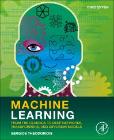
Machine Learning: From the Classics to Deep Networks, Transformers, and Diffusion Models
Theodoridis, Sergios
Machine Learning: From the Classics to Deep Networks, Transformers, and Diffusion Models, Third edition, gives a unified perspective on machine learning by covering both pillars of supervised learning, namely regression and classification. The book starts with the basics, including mean square, least squares and maximum likelihood methods, ridge regression, Bayesian decision theory classification, logistic regression, and decision trees. It then progresses to more recent techniques, covering sparse modelling methods, learning in reproducing kernel Hilbert spaces and support vector machines, Bayesian inference with a focus on the EM algorithm and its approximate inference variational versions, Monte Carlo methods, probabilistic graphical models focusing on Bayesian networks, hidden Markov models and particle filtering. Dimensionality reduction and latent variables modelling are also considered in depth. This palette of techniques concludes with an extended chapter on neural networks and deep learning architectures. The book also covers the fundamentals of statistical parameter estimation, Wiener and Kalman filtering, convexity and convex optimization, including a chapter on stochastic approximation and the gradient descent family of algorithms, presenting related online learning techniques as well as concepts and algorithmic versions for distributed optimization. Focusing on the physical reasoning behind the mathematics, without sacrificing rigor, all the various methods and techniques are explained in depth, supported by examples and problems, giving an invaluable resource to the student and researcher for understanding and applying machine learning concepts. Most of the chapters include typical case studies and computer exercises, both in MATLAB and Python. The chapters are written to be as self-contained as possible, making the text suitable for different courses: pattern recognition, statistical/adaptive signal processing, statistical/Bayesian learning, as well as courses on sparse modeling, deep learning, and probabilistic graphical models. Presents the physical reasoning, mathematical modeling and algorithmic implementation of each methodUpdates on the latest trends, including sparsity, convex analysis and optimization, online distributed algorithms, learning in RKH spaces, Bayesian inference, graphical and hidden Markov models, particle filtering, deep learning, dictionary learning and latent variables modelingProvides case studies on a variety of topics, including protein folding prediction, optical character recognition, text authorship identification, fMRI data analysis, change point detection, hyperspectral image unmixing, target localization, and more INDICE: 1. Introduction2. Probability and stochastic Processes3. Learning in parametric Modeling: Basic Concepts and Directions4. Mean-Square Error Linear Estimation5. Stochastic Gradient Descent: the LMS Algorithm and its Family6. The Least-Squares Family7. Classification: A Tour of the Classics8. Parameter Learning: A Convex Analytic Path9. Sparsity-Aware Learning: Concepts and Theoretical Foundations10. Sparsity-Aware Learning: Algorithms and Applications11. Learning in Reproducing Kernel Hilbert Spaces12. Bayesian Learning: Inference and the EM Algorithm13. Bayesian Learning: Approximate Inference and nonparametric Models14. Montel Carlo Methods15. Probabilistic Graphical Models: Part 116. Probabilistic Graphical Models: Part 217. Particle Filtering18. Neural Networks and Deep Learning19. Dimensionality Reduction and Latent Variables Modeling
- ISBN: 9780443292385
- Editorial: Academic Press
- Encuadernacion: Rústica
- Páginas: 1200
- Fecha Publicación: 01/01/2025
- Nº Volúmenes: 1
- Idioma: Inglés
